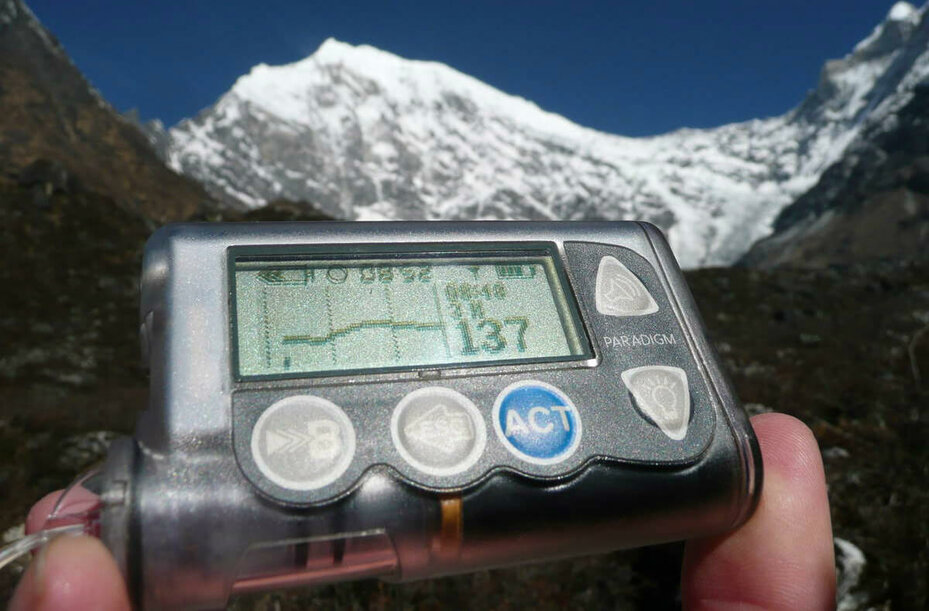« MENS SANA IN CORPORE SANO ». A healthy mind in a healthy body
But do sport, is sooo good! So like everything in our diabetic life, we must anticipate and learn from each experience. Understand our body and our diabetes to perform better, to go further, to climb higher
And the victory is all the more beautiful !!
Each sport has a different strategy. I adapt my insulin doses based on the physical activity. I have been using an insulin pump since 2008 (MiniMed™ 640G since May 2015), and it is so much easier to adjust my insulin flow / doses to manage my diabetes during and after exercise.
I love running, it gives me a great sense of freedom. I can sometimes forget my diabetes, as long as hypoglyceamia does not come to disturb me!. For a short and easy to moderate run (10km / h for one hour) I reduce my insulin flow (basal) to 75%, 30min before, and during the run. I make sure to run out of food so as not to have active insulin in my blood. Thanks to this reduction, I don’t need extra carbs before, during and after my run. Furthermore, I take one insulin unit (extra bolus) just after the run to avoid a post-exercise blood glucose rebound.
I ran my first marathon in October 2015 – The Twin Cities Marathon as a Global Hero. It was a new and amazing challenge…..and I made it ! I woke up at 4:30am (departure was at 8am) to ensure I didn’t have active insulin and a massive carbs arrival in my blood, I reduced my bolus of 25% (3 units for 40g of carbs). About my basal, I have reduced it by 85% 2 hours before, then for the first race 2 ½ hours (= 0,1u / h). Afterwards, my basal was only reduced by 50% (= 0,3u / h) because my pace was slower and I took sugar every 4km (8g). Throughout my marathon (4h22min) my blood sugar was between 130mg/dl - 150mg/dl (7.2 mmol/l – 8.3 mmol/l), which was my goal to avoid hypoglycaemia: o) A great successful challenge, and I would have no hesitation in running in this marathon again to win few minutes.
I discovered trekking in Nepal in 2007 and love it.
The good thing with trekking it is that it is not aggressive on blood sugar.
The physical effort is smooth and moderate which ensures blood sugar is under control. Some days I wish I could trek everyday as it is so great to see nice and smooth curves! I reduce my basal almost 50% (average - it depends on the height difference) and my bolus (breakfast and lunch) 20% because we often start walking in postprandial (simultaneous insulin action + carbs arrival + physical activity = 3 parameters to manage at the same time!).
Trekking can take us far away; and sometimes in remote high altitude regions which is an additional sporting challenge and a new challenge also for us diabetics. Whether in Nepal over 4500m (14 500ft) for 3 weeks, or during the Kilimanjaro’s ascent and its 5895m, I have learned the over 4500m logic! Normally 'I workout, I reduce my insulin units' but at that altitude a physiological stress exists: our blood sugar increases due to adrenaline (hyperglycaemic hormone). Thus, despite physical effort, insulin doses are not reduced. However, after one week of trekking over 4500m it seems that our body gets used to the altitude and the logic 'I workout, I reduce my insulin' becomes true ... this is my experience during my stays in high altitude.
Living our own Life and achieving our goals despite diabetes is possible. We learn from each life experience and from our peers. Technological advances, such as an insulin pump or CGM (Continuous Glucose Monitoring), are valuable aids to live fully our life!
Delphine Arduini, World Diabetes Tour Founder & CEO
